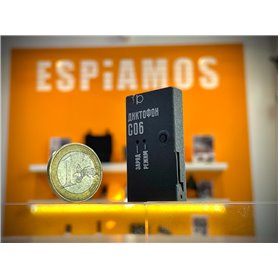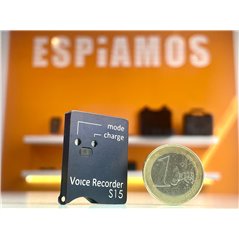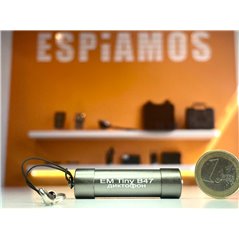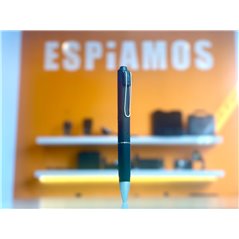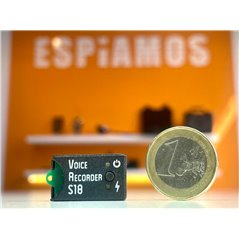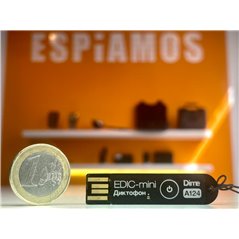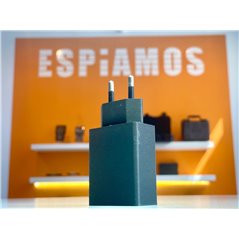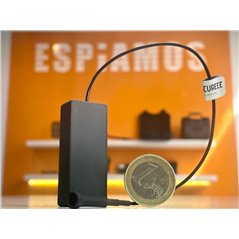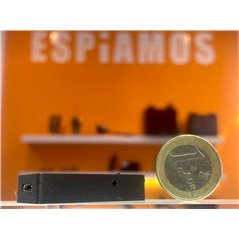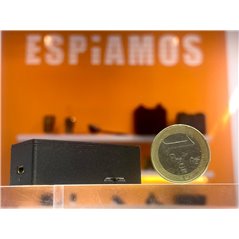
Classification by Function: Spy Audio Devices for Every Need
Spy audio devices can be classified according to their specific design. Depending on the surveillance or intelligence gathering objective, there are devices with advanced features that optimize sound capture in different environments. Within this classification, we find sound-activated voice recorders, long-range microphones, devices with audio encryption, and microphones with real-time listening , each adapted to different uses.
At ESPIAMOS® , we offer a wide selection of spy audio devices designed for covert monitoring, personal security, and evidence collection . Each device is optimized to ensure the highest sound quality and discretion.
Main Uses of Spy Audio Devices According to Their Function
- Sound-Activated Recorders: Automatically activate when noise is detected, allowing you to record only relevant moments and save storage space.
- Long-Range Spy Microphones: Designed to capture sounds at considerable distances, ideal for surveillance outdoors or in large spaces.
- Audio Encryption Microphones: Protect sound transmission to prevent interception, ensuring secure communications.
- Real-Time Listening Microphones: Allows immediate monitoring of the environment via GSM, WiFi, or radio frequency.
- Contact Microphones: Pick up sound through walls and solid surfaces, allowing you to hear conversations in adjacent rooms.
Types and Key Features of Spy Audio Devices According to Their Function
Spy audio devices are designed with specific functions for different surveillance and security scenarios. Depending on the intended use, we can find models with automatic recording, live streaming, long-range capture, or audio encryption . Below, we present the main functions of these devices and their most relevant features.
Sound-Activated Voice Recorders
These spy recorders are designed to automatically start recording when they detect noise in the environment. They're ideal for optimizing storage and capturing only relevant conversations or events.
- Memory and Battery Saving: They only record when sound is detected, prolonging their battery life.
- Standby Mode: They can remain inactive for days or weeks and activate only when there is audio.
- Internal or microSD Storage: Save recordings to built-in or removable memory.
- Hidden Formats: Available in pens, USBs or credit cards for maximum discretion.
Long Range Spy Microphones
These devices are designed to capture sound at greater distances than a conventional microphone. They are used for outdoor surveillance, in auditoriums, or in large spaces .
- Directional Sound Pickup: Filters out ambient noise to focus on the audio source.
- Models with Amplification: Allow you to hear distant conversations more clearly.
- Compact Design: Discreet models that can be easily camouflaged.
- Portable Power Supply: They work with rechargeable batteries or external power supply.
Microphones with Audio Encryption
Encrypted microphones ensure that audio transmission cannot be intercepted, offering maximum security in sensitive environments.
- End-to-End Encryption: Protects transmissions from unauthorized eavesdropping.
- Used in Secure Communications: Ideal for executives, governments and security forces.
- Compatible with Private Networks: They can connect to secure servers for remote streaming.
- Models with Customizable Configuration: Allows you to adjust security levels according to your needs.
Microphones with Real-Time Listening
These spy microphones allow remote monitoring of the environment using technologies such as GSM, WiFi or radio frequency .
- GSM microphones: Activated by a phone call, they allow listening from anywhere in the world.
- WiFi Microphones: Stream live audio to a mobile app or PC.
- Radio Frequency Microphones: Send audio to a receiver without the need for internet or mobile networks.
- Auto Call Function: Some models can activate transmission when they detect sound.
Contact Microphones
These devices can detect sound through walls, ceilings, or solid surfaces by detecting vibrations.
- Audio Pickup Through Structures: Transform vibrations into clear sound.
- Use in Discreet Surveillance: They are used in investigations and security.
- Models with Adjustable Amplification: Allows you to increase the microphone sensitivity.
- Compact and Portable Design: Easy to carry and use in different scenarios.
Where to Buy Spy Audio Devices According to Their Function?
At ESPIAMOS® , we offer a selection of voice recorders and spy microphones designed for every security and surveillance need. We also guarantee exclusive benefits for our customers:
- Specialized Technical Advice: Our team will help you choose the best device for your needs.
- Official 3-Year Warranty: All our products come with an extended warranty that ensures proper operation.
- Discreet and Secure Shipping: All orders are delivered in packages without visible identification.
- Secure Payments and Total Privacy: Transactions are processed securely, with only the “HID” symbol appearing on bank statements.
- Permanent Stock and Immediate Delivery: We have products available for shipment without unnecessary waits.
Discover our selection of spy audio devices and choose the best equipment for your security and surveillance needs.
Frequently Asked Questions About Audio Surveillance Devices
What benefits does sound activation offer on a recorder?
This type of technology allows the device to begin recording only when it detects noise in the environment. This saves battery and storage space, avoiding hours of unnecessary recording. It's also especially useful in environments where you want to capture specific conversations without manual intervention. This is a common feature in discreet recorders designed for long-term and effective use in monitoring or evidence collection tasks.
Can I pick up conversations from a distance with a specialized microphone?
There are models specifically designed to reach distant sound sources. These devices feature directional systems and amplification that allow voices or noises to be identified from several meters away, even outdoors. It's important to keep in mind that the effective distance will depend on factors such as the environment, noise level, and the quality of the device. They are frequently used for surveillance of large spaces or from strategic positions.
Why use an encrypted audio system?
When transmitting audio remotely, third parties may attempt to intercept the signal. Equipment that incorporates encryption prevents unauthorized access, guaranteeing the privacy of the communication. These tools are highly valued in professional environments where data protection is a priority, such as companies, institutions, or law enforcement agencies. End-to-end encryption ensures that only the authorized recipient can access the recorded or transmitted content.
What options do I have if I want to monitor a space in real time?
There are solutions that allow you to listen to what is happening in an environment from anywhere. Some models work via cellular networks and are activated upon receiving a call, while others use a Wi-Fi connection to stream live audio to an app. There are also devices that use radio frequency over shorter distances. This functionality is key when an immediate response is needed in potentially dangerous situations.
Is listening through walls reliable?
Devices designed for this purpose use sensors capable of detecting sound vibrations through solid materials. Although quality can vary depending on the thickness and type of surface, high-end models can deliver clear sound even through robust structures. This is a common technique in investigations or to verify what is happening in adjacent rooms without the need for direct physical access.
How long can a device be active in surveillance mode?
Battery life will depend on the size of the battery and how the device is configured. A sound-activated device can be on standby for weeks or even months, as it only consumes power when recording. However, if it's recording or streaming continuously, the standby time is significantly reduced. Some models also allow external power for extended, uninterrupted monitoring.
Is there a way to prevent these devices from being detected?
Devices that store audio locally, without emitting signals, are very difficult to locate, even with specialized technology. On the other hand, those that broadcast live can be identified by frequency detectors if not properly configured. To minimize risks, it is advisable to use low-emission models or those designed with detection protection measures. Their discretion also depends on how and where they are installed.






 WhatsApp
WhatsApp Telegram
Telegram



